Hybrid cucumber “Grandma’s granddaughter f1”: description and features of agricultural technology
Many amateur gardeners prefer cucumber Grandmother's granddaughter f1. The hybrid gained its popularity due to its stable high yield, excellent taste of fruits and resistance to major diseases. The culture is unpretentious in care and quickly adapts to temperature changes. Grows equally well in open and closed ground.
Description
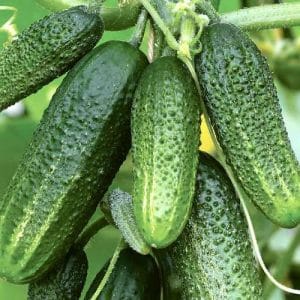
Hybrid cucumber Grandma's grandson was bred by crossing two varieties with early ripening. The vegetable was officially included in the State Register in 2012.
The culture belongs to the parthenocarpic (self-pollinating) type. Each flower consists of stamens and pistil. Cucumbers are cultivated in open ground and greenhouse conditions.
The ripening period is early: 38–42 days pass from the emergence of seedlings to harvesting.
The fruits themselves have an attractive presentation; they can easily withstand transportation, maintaining their beneficial properties and unchanged composition. Suitable for growing for sale.
Distinctive features
The hybrid Grandmother's granddaughter f1 has a bouquet type of flowering (more than 3 ovaries are formed in one node).
Other characteristic features of the culture:
- high yield, 2-3 times higher than similar varieties;
- formation in each node from 5 to 12 ovaries;
- resistance to temperature changes;
- limited growth of side shoots;
- resistance to powdery mildew, cladosporiosis and root rot;
- the location of the fruits in the node is from 2 to 4.
Cucumber takes up little space on the site: 3–5 plants are placed per 1 m2.
Composition and benefits
The hybrid contains many useful substances:
- vitamins - C, A, PP, B1, B2, beta-carotene;
- trace elements - zinc, iron, potassium, manganese, magnesium, iodine, copper, folic acid, chromium, sodium, chlorine, phosphorus.
Cucumber is easily absorbed by the body, as it consists of 90% structured water. It improves the condition of the thyroid gland, prevents urolithiasis, varicose veins, disorders of the cardiovascular system, and reduces the content of harmful cholesterol in the blood. Removes waste, toxins and heavy metal salts from the body.
Fruits mainly consist of fiber, which is easily and quickly digested. The calorie content of cucumber is low - 15 kcal per 100 g; it is added to the daily diet during a diet and a healthy diet.
Characteristics of bushes and fruits
Medium height hybrid. The branches grow sparsely. The leaves are deep green and medium in size. Female type flowers.
Fruit characteristics:
- oval-cylindrical shape, slightly shortened;
- length - 9–11 cm;
- weight - 75–115 g;
- diameter - up to 2.5 cm;
- the color is uneven: dark green at the base and lighter closer to the top;
- fruits with longitudinal yellow stripes and noticeable spotting;
- the skin is covered with tubercles and light spines;
- the pulp is light green in color with a dense structure;
- when bitten, the fruits produce a characteristic crunch;
- the taste is pleasant without bitterness;
- the aroma is refreshing;
- seed chambers are small.
The yield of the hybrid is high: 11-12 kg per 1 m2.
How to grow your own
The hybrid is intended for independent cultivation on a personal plot. Sowing time: from late April to early May.
The quality of the harvest depends on compliance with the rules for preparing seeds, planting crops in the ground and caring for young plants.
Planting by seed and seedling methods
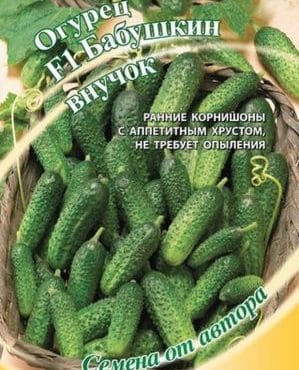
Before planting, the seeds are inspected: the smallest and most damaged ones are separated. They are not usable.
Afterwards the material is processed:
- placed in a 3% solution of potassium permanganate for 20–30 minutes for disinfection;
- then placed in a growth stimulator, according to the attached instructions.
Plant the seeds in small containers (peat pots or longitudinal boxes) or directly into the ground.
For the seedling method, the soil is purchased from a specialized store or prepared independently by mixing compost, peat, humus and sand. The grains are buried 2–2.5 cm.
When planting in containers, observe the following nuances:
- the container is covered with a plastic bag;
- maintain a stable temperature - +25...+30 °C;
- illuminated for more than 12–14 hours, for which phytolamps are additionally installed;
- open the containers daily and spray the soil with a spray bottle.
Requirements for planting in open ground:
- wait for a stable soil temperature of about +13...+15 °C (there should be no night frosts);
- make rows with a distance of 50 cm;
- Place 2 seeds per hole, plant them every 30 cm.
If there is a possible decrease in night temperature, a film shelter is built over the landing site.
Attention! Seedlings are transplanted from containers into open ground after 2 weeks, when 2-3 leaves appear.
Growing and care
After 5-6 days, the first shoots should appear. If the seedlings are in a greenhouse, then the room is opened for several hours a day to allow oxygen to enter and maintain air humidity at a normal level.
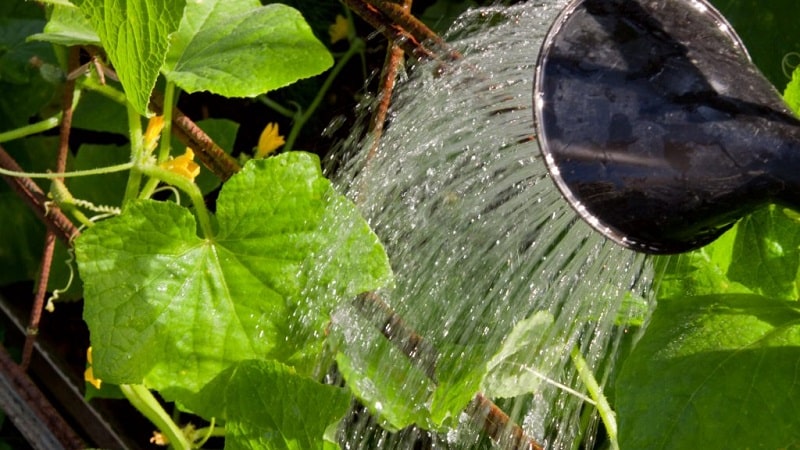
When growing, adhere to a number of recommendations:
- water the bushes only with warm, settled water in the morning or evening - on hot days, irrigate the seedlings 2 times a day;
- It is advisable to remove weeds and loosen the soil every time you moisten;
- the soil is periodically hilled up, the loosened soil is sprinkled onto the stems of plants, this will ensure their stability and better development of the root system;
- As the hybrid grows, the stem is tied to wooden posts with cotton tape or twine, preventing the stem from being pulled over.
Feeding Apply several times at different stages of growth:
- 10–14 days after transplantation;
- during flowering;
- during the fruiting period.
Organic fertilizers are used: ammonium nitrate, potassium preparations and superphosphate. The product is diluted in water and poured directly under the root. Make sure that the solution does not get on the leaves or stem of the crop.
Features of cultivation and possible difficulties
Cucumber is grown in any soil where there is drainage and good aeration. However, the soil should be light and rich in humus.
In order for the hybrid to grow better, it is not planted in the same place every season in a row. They wait 4 years. Good predecessors are tomatoes, potatoes, peas and corn, and undesirable ones are strawberries, pumpkin, zucchini, watermelon and melon.
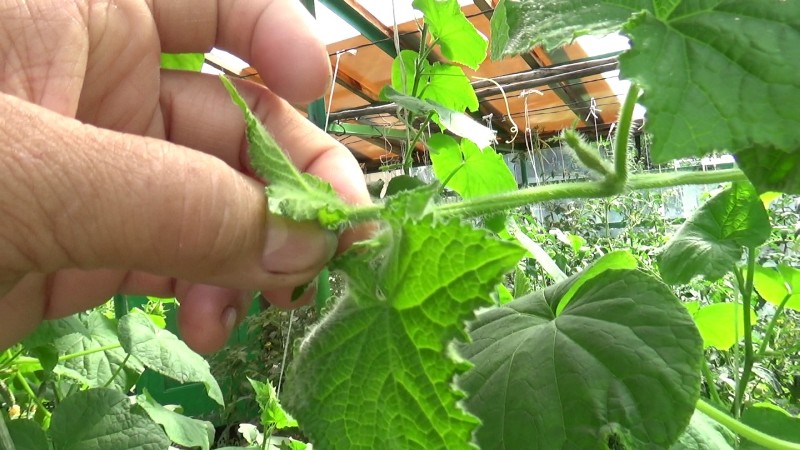
Difficulties in growing crops:
- if water does not seep through well during watering, carefully make several indentations with a rake so as not to damage the roots of the plants;
- to prevent excessive growth of bushes, pinch the main stem after 6-7 leaves have formed;
- If the fruits are picked at the wrong time, they will become overripe and the peel will become rough.
Important! The harvest is collected regularly: several times a week. This stimulates the bushes to form more fruits.
Diseases and pests
The hybrid is resistant to powdery mildew, brown spot, root rot, cucumber mosaic and downy mildew.The crop is practically not attacked by insect pests.
Causes of possible infection:
- abundance of weeds;
- excessive soil irrigation;
- high humidity;
- incorrect crop rotation.
To prevent diseases, the bushes are carefully inspected each time you water. If dark spots, chewed leaves or signs of drying appear, the plants are treated with special means (Fitosporin, Bordeaux mixture, Quadris or Tiram).
Harvesting and application
Vegetables are harvested throughout the season. They are used for fresh consumption, added to salads and various dishes, canned, marinate And salted.
The hybrid is grown on an industrial scale on farms. The harvested crop is sold at retail and canned at enterprises.
Advantages and disadvantages
Grandmother’s grandson has a wide range of advantages, including:
- self-pollination;
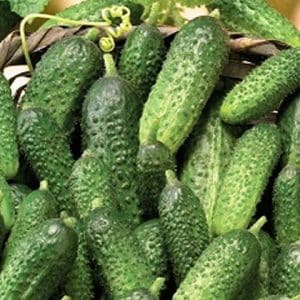
- outdoor and greenhouse cultivation;
- resistance to temperature changes;
- fruit collection throughout the season;
- high productivity;
- resistance to diseases characteristic of the culture;
- low maintenance requirements;
- excellent taste of vegetables and healthy composition;
- versatility in application;
- preservation of fruits, their sale.
The plant has practically no disadvantages. They only note sensitivity to drying out of the soil and roughening of the skins of vegetables when overripe.
Important! To preserve their presentation, cucumbers are not picked, but carefully cut with a sharp garden tool.
Reviews
Vegetable growers note the high yield of the hybrid, ease of care and excellent taste of the fruit.
Anastasia, Voronezh: “I planted Grandma’s granddaughter for the first time. First in pots, then in the garden.It began to bear fruit quickly; all I had time to do was pick crispy cucumbers. I’m very pleased.”
Vladimir, Kursk: “This is not the first year I have been planting. I like that I collect several kilograms from each bush. During the season I am fully supplied with cucumbers. They have a pleasant taste and no bitterness at all. I’ve never encountered any illnesses.”
Maria, Kislovodsk: “Every year I spend the summer at the dacha. I have been growing this hybrid for the third year in a row. It doesn’t need special care - I just tie it up, water it and weed it on time. I close the remaining harvest for the winter. I’ll be provided with delicious cucumbers all year round.”
Read also:
The cucumber that has won the hearts of many farmers is “Perfection itself f1.”
How to properly prepare pickled cucumbers and carrots for the winter.
Very tasty and aromatic Alligator cucumber for fresh consumption.
Conclusion
Hybrid cucumber Grandma's granddaughter f1 does not require special care. Grows equally well in open ground and greenhouse conditions. The yield is stable and high (11-12 kg per 1 m2) throughout the whole season. Resistant to major diseases and pests. Cucumbers are crispy, with a delicate taste and fresh aroma.